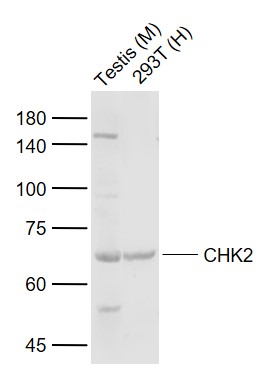
Rabbit Anti-CHEK2 antibody
CHK2_HUMAN; Serine/threonine-protein kinase Chk2; EC:2.7.11.1; Serine/threonine-protein kinase Chk2; CDS1; CHK2; LFS2; RAD53; hCds1; HuCds1; PP1425; CHK2 checkpoint homolog; Cds1 homolog (Hucds1; hCds1); Checkpoint kinase 2;
View History [Clear]
Details
Product Name CHEK2 Chinese Name 丝氨酸蛋白激酶1抗体 Alias CHK2_HUMAN; Serine/threonine-protein kinase Chk2; EC:2.7.11.1; Serine/threonine-protein kinase Chk2; CDS1; CHK2; LFS2; RAD53; hCds1; HuCds1; PP1425; CHK2 checkpoint homolog; Cds1 homolog (Hucds1; hCds1); Checkpoint kinase 2; Research Area Cell biology Cyclin Kinases and Phosphatases Epigenetics Immunogen Species Rabbit Clonality Polyclonal React Species Human, Mouse, (predicted: Rat, Dog, Pig, Cow, Horse, Rabbit, Sheep, ) Applications WB=1:500-2000 ELISA=1:5000-10000
not yet tested in other applications.
optimal dilutions/concentrations should be determined by the end user.Theoretical molecular weight 61kDa Cellular localization The cell membrane Form Liquid Concentration 1mg/ml immunogen KLH conjugated synthetic peptide derived from human CHEK2: 101-200/543 Lsotype IgG Purification affinity purified by Protein A Buffer Solution 0.01M TBS(pH7.4) with 1% BSA, 0.03% Proclin300 and 50% Glycerol. Storage Shipped at 4℃. Store at -20 °C for one year. Avoid repeated freeze/thaw cycles. Attention This product as supplied is intended for research use only, not for use in human, therapeutic or diagnostic applications. PubMed PubMed Product Detail In response to DNA damage and replication blocks, cell cycle progression is halted through the control of critical cell cycle regulators. The protein encoded by this gene is a cell cycle checkpoint regulator and putative tumor suppressor. It contains a forkhead-associated protein interaction domain essential for activation in response to DNA damage and is rapidly phosphorylated in response to replication blocks and DNA damage. When activated, the encoded protein is known to inhibit CDC25C phosphatase, preventing entry into mitosis, and has been shown to stabilize the tumor suppressor protein p53, leading to cell cycle arrest in G1. In addition, this protein interacts with and phosphorylates BRCA1, allowing BRCA1 to restore survival after DNA damage. Mutations in this gene have been linked with Li-Fraumeni syndrome, a highly penetrant familial cancer phenotype usually associated with inherited mutations in TP53. Also, mutations in this gene are thought to confer a predisposition to sarcomas, breast cancer, and brain tumors. This nuclear protein is a member of the CDS1 subfamily of serine/threonine protein kinases. Several transcript variants encoding different isoforms have been found for this gene. [provided by RefSeq, Apr 2012]
Function:
Controls S-phase checkpoint as well as G1 and G2 DNA damage checkpoints. Phosphorylates proteins on serine, threonine, and tyrosine. Prevents entry into anaphase and mitotic exit after DNA damage via regulation of the Polo kinase CDC5. Seems to be involved in the phosphorylation of RPH1.
Subunit:
Homodimer. Homodimerization is part of the activation process but the dimer may dissociate following activation. Interacts with PML. Interacts with TP53. Interacts with RB1; phosphorylates RB1. Interacts with BRCA1. Interacts (phosphorylated at Thr-68) with MDC1; requires ATM-mediated phosphorylation of CHEK2. Interacts with TP53BP1; modulates CHEK2 phosphorylation at Thr-68 in response to ionizing radiation. Interacts with CDC25A; phosphorylates CDC25A and mediates its degradation in response to ionizing radiation. Interacts with CUL1; mediates CHEK2 ubiquitination and regulation.
Tissue Specificity:
Nucleus.
Post-translational modifications:
Autophosphorylated.
Similarity:
Belongs to the protein kinase superfamily. CAMK Ser/Thr protein kinase family. CHEK2 subfamily.
Contains 2 FHA domains.
Contains 1 protein kinase domain.
SWISS:
O96017
Gene ID:
11200
Database links:Entrez Gene: 11200 Human
Entrez Gene: 50883 Mouse
SwissProt: O96017 Human
SwissProt: Q9Z265 Mouse
Product Picture
Bought notes(bought amounts latest0)
No one bought this product
User Comment(Total0User Comment Num)
- No comment



 +86 571 56623320
+86 571 56623320
 +86 18668110335
+86 18668110335

